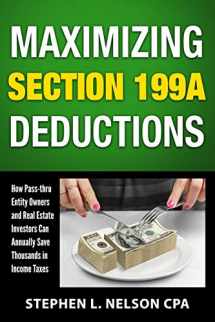
Maximizing Section 199A Deductions: How Pass-through Entity Owners and Real Estate Investors Can Annually Save Thousands in Income Taxes
Book details
Summary
Description
The new Section 199A business deduction should save business owners and real estate investors thousands of dollars of tax annually. How? Section 199A provides owners of pass-through entities with a deduction equal, potentially, to 20% of their business income. Unfortunately, the 20 page law and nearly 300 pages of regulations burden small businesses and individual investors with tricky rules and complicated accounting.
Hence, this book for tax accountants, financial advisers, business attorneys and sophisticated business owners... "Maximizing Section 199A Deductions" covers in detail how the new deduction works with up-to-date information and insights for the 2019 tax filing season.
Need more detailed information? Maximizing Section 199A Deductions includes the following chapters:
*Chapter 1 - The Section 199A Deduction in a Nutshell: An overview of the deduction to understand the big picture and begin thinking in broad brush strokes about how the deduction works for small businesses, real estate investors, and investors in REITs and qualified publicly traded partnerships.
*Chapter 2 - What Counts as Qualified Business Income: Detailed discussions of exactly what types of business income taxpayers can shelter with the Section 199A deduction, with specific discussions of the rules that apply to different types of business owners and investors: sole proprietorships, partnerships, S corporations, trusts and estates, and then investors in REITs and qualified publicly traded partnership. Also, coverage of how qualified business income accounting works for Section 1031 exchanges, Section 1031 involuntary transfers and for Section 351 incorporations and Section 721 partnership formations.
*Chapter 3 - Specified Service Trade or Business Disqualification: In-depth coverage of which types of businesses lose some or all of the Section 199A deduction as a result of falling into a specified service trade or business like health services, law, consulting, accounting, actuarial science, performing arts, athletics, investment services, brokerage and trading services, and situations where the business relies on the skill or reputation of a single celebrity.
*Chapter 4 - Accounting for W-2 Wages and Depreciable Property: Every pass-through entity (so every partnership and S corporation) needs to provide detailed accounting for a business's wages and depreciable property because some taxpayers need this information to calculate their Section 199A deduction. Chapter 4 walks the reader through this burdensome area of the new law.
*Chapter 5 - Multiple Trades or Businesses: Chapter 5 describes the additional accounting and reporting required for situations where an individual owns interests in multiple trades or businesses. Chapter 5 also describes the rules for making an aggregation election-and when the aggregation election makes sense.
*Chapter 6 - Fourteen Section 199A Deduction Tax Planning Tips: More than a dozen practical, common-sensed tactics taxpayers can use to save thousands in taxes.
*Chapter 7 - Un-incorporation and S Status Revocation: Detailed analysis of when an S corporation should liquidate or revoke its S corporation status to maximize tax savings.
*Chapter 8 - Section 199A Tax Return Preparation Checklist: Just what it says: A checklist of steps taxpayers will want to take to maximize the deduction on the upcoming 2019 tax return.
*Chapter 9 - Agricultural & Horticultural Cooperatives and their Patrons: Overview discussion and examples of the rules (including the "grain glitch" fix) for specified agricultural and horticultural cooperatives and their members.
The book also includes Section 199A FAQs tax professionals can share with their clients (via email or traditional letters) and the text of the Section 199A law including the technical corrections.


We would LOVE it if you could help us and other readers by reviewing the book
Book review



